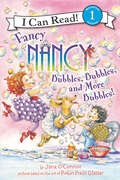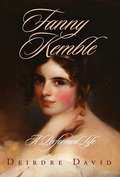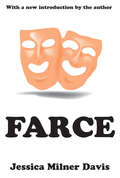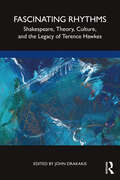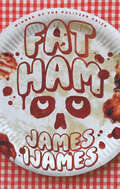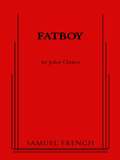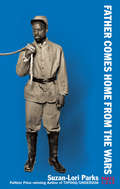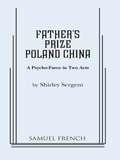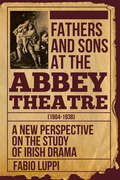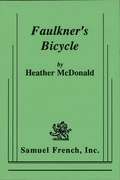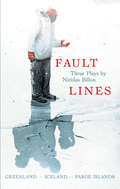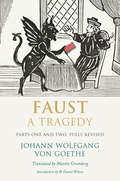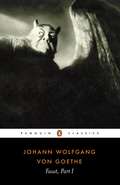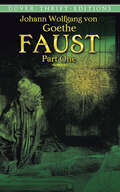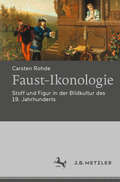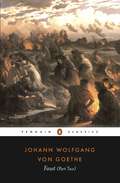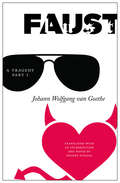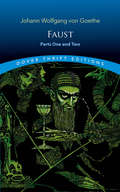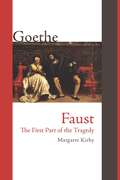- Table View
- List View
Fancy Nancy: Bubbles, Bubbles, and More Bubbles! (I Can Read Level 1)
by Jane O'ConnorFancy Nancy and her class are going to see The Big Bubble Show!Nancy and Bree can’t wait to go. But when Bree gets sick and has to miss the show, Nancy decides to put on a bubble show of her own. Will Nancy and her classmates be able to put on the best bubble show ever?From the beloved New York Times bestselling author-illustrator team Jane O’Connor and Robin Preiss Glasser, Fancy Nancy: Bubbles, Bubbles, and More Bubbles is a Level One I Can Read, perfect for children learning to sound out words and sentences.
Fanny Kemble
by Deirdre DavidA ForeWord magazine Book of the Year for 2007Charismatic, highly intelligent, and splendidly talented, Fanny Kemble (1809-93) was a Victorian celebrity, known on both sides of the Atlantic as an actress and member of the famous Kemble theatrical dynasty, as a fierce opponent of slavery despite her marriage to a wealthy slave owner, as a brilliantly successful solo performer of Shakespeare, and as the author of journals about her career and life on her husband's Georgia plantations. She was, in her own words, irresistible as a "woman who has sat at dinner alongside Byron . . . and who calls Tennyson, Alfred."Touring in America with her father in the early 1830s, Kemble impulsively wed the wealthy and charming Philadelphia bachelor Pierce Butler, beginning a tumultuous marriage that ended in a sensational divorce and custody battle fourteen years later. At the time of their marriage, Kemble had not yet visited the vast Georgia rice and cotton plantations to which Butler was heir. In the winter of 1838, they visited Butler's southern holdings, and a horrified Kemble wrote what would later be published on both sides of the Atlantic as Journal of a Residence on a Georgian Plantation. An important text for abolitionists, it revealed the inner workings of a plantation and the appalling conditions in which slaves lived. Returning to England after her divorce, she fashioned a new career as a solo performer of Shakespeare's plays and as the author of memoirs, several travel narratives and collections of poems, a short novel, and miscellaneous essays on the theater. For the rest of her life, she would divide her time between the two countries.In the various roles she performed in her life, on stage and off--abolitionist, author, estranged wife--Kemble remained highly theatrical, appropriating and subverting nineteenth-century prescriptions for women's lives, ever rewriting the roles to which she was assigned by society and inheritance. Hers was truly a performed life, and in the first Kemble biography in twenty-five years to examine that life in its entirety, Deirdre David presents it in all its richness and complexity.
Farce (Transaction Series In Humor Ser.)
by Jessica Milner DavisFarce has always been relegated to the lowest rung of the ladder of dramatic genres. Distinctions between farce and more literary comic forms remain clouded, even in the light of contemporary efforts to rehabilitate this type of comedy. Is farce really nothing more than slapstick-the "putting out of candles, kicking down of tables, falling over joynt-stools," as Thomas Shadwell characterized it in the seventeenth century? Or was his contemporary, Nahum Tate correct when he declared triumphantly that "there are no rules to be prescribed for that sort of wit, no patterns to copy; and 'tis altogether the creature of imagination"? Davis shows farce to be an essential component in both the comedic and tragic traditions. Farce sets out to explore the territory of what makes farce distinct as a comic genre. Its lowly origins date back to the classic Graeco-Roman theatre; but when formal drama was reborn by the process of elaboration of ritual within the mediaeval Church, the French term "farce" became synonymous with a recognizable style of comic performance. Taking a wide range of farces from the briefest and most basic of fair-ground mountebank performances to fully-fledged five-act structures from the late nineteenth century, the book reveals the patterns of comic plot and counter-plot that are common to all. The result is a novel classification of farce-plots, which serves to clarify the differences between farce and more literary comic forms and to show how quickly farce can shade into other styles of humor. The key is a careful balance between a revolt against order and propriety, and a kind of Realpolitik which ultimately restores the social conventions under attack. A complex array of devices in such things as framing, plot, characterization, timing and acting style maintain the delicate balance. Contemporary examples from the London stage bring the discussion u
Fascinating Rhythms: Shakespeare, Theory, Culture, and the Legacy of Terence Hawkes
by John DrakakisAs one of the most adventurous literary and cultural critics of his generation, Terence Hawkes’ contributions to the study of Shakespeare and the development of literary and cultural theory have been immense. His work has been instrumental in effecting a radical shift in the study of Shakespeare and of literary studies. This collection of essays by some of his closest colleagues, friends, peers, and mentees begins with an introduction by John Drakakis, outlining the profound impact that Hawkes’ work had on various areas of literary studies. It also includes a poem by Christopher Norris, who worked with Hawkes for many years at the University of Cardiff, as well as work on translation, social class, the historicist and presentist exploration of Shakespearean texts, and teaching Shakespeare in prisons. The volume features essays by former students who have gone on to establish reputations in areas beyond the study of literature, and who have contributed ground-breaking volumes to the pioneering New Accents series. It concludes with Malcolm Evans’ innovative account of the migration of semiotics into the area of business. This book is a vibrant and informative read for anyone interested in Hawkes’ unique blend of literary and cultural theory, criticism, Shakespeare studies, and presentism.
Fat Ham
by James IjamesJuicy—a young, queer, Southern man, who is grappling with questions of identity—is visited by the ghost of his father (Pap) at his mother’s wedding/family barbecue. Pap demands that Juicy avenge his recent murder. How will Juicy, a sensitive and self-aware young Black man, trying to break a cycle of trauma and toxic masculinity, avenge his father’s premature death? Fat Ham reinvents Shakespeare’s masterpiece in startling and hilarious ways amidst the backdrop of a family barbeque in the American South.
Fatboy
by John ClancyJohn Clancy / 3m, 2f / Fatboy is a brutal comedy inspired by Alfred Jarry's Ubu Roi. This satire on modern America's insatiable appetites--from gobbling up 72oz. steaks to small nations--is presented as a live-action Punch and Judy show. In this fast-moving, shocking, profane, dead-on, funhouse mirror reflection of the world today, the brutish allegory known as Fatboy, along with his monstrous wife, Queen Fudgie the First, stands trial for war crimes. Despite overwhelming evidence the court refuses to convict and succumbs to Fatboy's "persuasive" tactics. / "Brazen...daring...highly entertaining." - Jason Zinoman, The New York Times
Father Comes Home From the Wars (Parts 1, 2 & #3)
by Suzan-Lori Parks"By turns philosophical and playful, lyrical and earthy, Father Comes Home from the Wars (Parts 1, 2 & 3), swoops, leaps, dives and soars, reimagining a turbulent point in American history through a cockeyed contemporary lens . . . The finest work yet from this gifted writer."--The New York Times"Thrilling. . . . A masterpiece . . . A story that engages the deepest possible issues in the most gripping possible ways."--New YorkOffered his freedom if he joins his master in the ranks of the Confederacy, Hero, a slave, must choose whether to leave the woman and people he loves for what may be another empty promise. As his decision brings him face to face with a nation at war with itself, the ones Hero left behind debate whether to escape or wait for his return, only to discover that for Hero, freedom may have come at a great spiritual cost. A devastatingly beautiful dramatic work, Father Comes Home from the Wars (Parts 1, 2, & 3) is the opening trilogy of a projected nine-play cycle that will ultimately take us into the present.Suzan-Lori Parks became the first African American woman to receive the Pulitzer Prize for Drama for her play Topdog/Underdog in 2002. Her other plays include The Book of Grace, In the Blood, Venus, The Death of the Last Black Man in the Whole Entire World, Fucking A, Imperceptible Mutabilities in the Third Kingdom and The America Play. In 2007 her 365 Days/365 Plays was produced at more than seven hundred theaters worldwide. Parks is a MacArthur Fellow and the Master Writer Chair at the Public Theater.
Father's Chinese Opera
by Rich LoThe Chinese opera is anything but boring. Songs, acrobatics, acting, and costumes make the opera a truly spectacular show to behold. Spending a summer backstage at his father's Chinese opera, a young boy is instantly enamored with the performers and works hard to be a part of the show. Rehearsing the moves day and night with the show's famous choreographer, the boy thinks he is soon ready to perform with the others. But the choreographer doesn't agree. In fact, he laughs at the boy when asked to join the others in the acrobatics part of the opera. Upset, the boy runs home to sulk. What will he do next? Will he give up, or will he persevere and work his way up in the show? <p><p> In an exotic and intriguing story that draws on author Rich Lo's personal life, and features his own bright, mesmerizing illustrations, Father's Chinese Opera teaches children about hard work, patience, and the commitment needed to achieve an important goal, while introducing them to an important part of Chinese culture.
Father's Prize Poland Chin
by Shirley SergentOnce upon a time there lived in the heartland of America a farmer who had a successive string of prize Poland China hogs and two daughters, one plain and home grown, the other pretty and home flown. A gigolo enters their lives in a most upsetting manner. The plain daughter misconstrues his attentions and tumbles head over heels for the man, his charm and his high shining boots. It's the pretty one, however, who spends her nights entertaining the gigolo and ends up a fool for love with a black eye. The plain daughter intends to lure the gigolo into marriage by sharing with him the deed to the farm. But a third women who has lured father into marriage also has her eye on the deed. A lot of squealing ensues from both humans and hogs when the gigolo is found shot to death and discovered to have been married with children. Who did it? And what's wrong with father? Is he dead or alive? And what has become of the prize hog? It's a rollicking ending to a cleverly funny play. Winner of the American College Theatre Festival XXVI.
Fathers and Sons at the Abbey Theatre (1904-1938): A New Perspective on the Study of Irish Drama
by Fabio LuppiFathers and Sons at the Abbey Theatre demonstrates how the literary archetype of the clash between fathers and sons and the subsequent depiction of anti-oedipal figures become a major concern for the playwrights writing in a specific and crucial moment of Irish history (1904-1938). The father can be conceived both as a historical / political metaphor as well as a real father in a specific historical and social context. The classical models employed as theoretical tools to nuance the argument--Laius and Oedipus, Ulysses and Telemachus, Aeneas and Anchises, Priam and Hector, Hector and Astyanax--are challenged by the Christian example of Abraham and Isaac, subversively adjusted by Yeats to provide a tragic reading of post-colonial Ireland. All of these pairings provide archetypes for the understanding of complex personal and familial dynamics.°The book takes into consideration not only the most famous figures of the Irish National Theatre--as W.B. Yeats, J.M. Synge, Augusta Gregory, and Sean O'Casey--but also overlooked authors such as T.C. Murray, Padraic Colum, Paul Vincent Carroll, Lennox Robinson, Denis Johnston, George Shiels, St. John Ervine, Teresa Deevy. Many commentators have written about the playwrights of the Abbey Theatre, mainly focusing on politics, social classes, Irish identity, cultural issues, and linguistic aspects: no thorough analysis of the clash between generations has been published so far. Those who have tackled the issue have devoted their attention to a single author, or to a single aspect; this study aims to demonstrate that the repeated occurrence of anti-oedipal figures and of the archetype of the clash between fathers and sons?a clear manifestation of the need of emancipation from oppressive authorities and of change in Irish society?must be read as a common phenomenon and as a shared concern. The book is written for people interested in Irish studies, post-colonial studies, and theatre studies.
Fathers and Sons in Shakespeare
by Fred B. TromlySome of Shakespeare's most memorable male characters, such as Hamlet, Prince Hal, and Edgar, are defined by their relationships with their fathers. In Fathers and Sons in Shakespeare, Fred B. Tromly demonstrates that these relationships are far more complicated than most critics have assumed. While Shakespearean sons often act as their fathers' steadfast defenders, they simultaneously resist paternal encroachment on their autonomy, tempering vigorous loyalty with subtle hostility.Tromly's introductory chapters draw on both Freudian psychology and Elizabethan family history to frame the issue of filial ambivalence in Shakespeare. The following analytical chapters mine the father-son relationships in plays that span Shakespeare's entire career. The conclusion explores Shakespeare's relationship with his own father and its effect on his fictional depictions of life as a son. Through careful scrutiny of word and deed, the scholarship in Fathers and Sons in Shakespeare reveals the complex attitude Shakespeare's sons harbour towards their fathers.
Faulkner's Bicycle
by Heather McdonaldDrama / 1m, 3f / Blossoming wallflowers, the terrors of senility, the isolation of intellect and fear of failure are themes of this play about a journalist who, dispirited at the lack of passion in her life, returns home to Oxford, Mississippi, where her sister and ailing mother have an irritating neighbor: Bill Faulkner. While mother plays Chopin, plans a lavish garden, and dresses for a final tea party with the illustrious writer she has known since childhood, he rides his bicycle drunkenly about town at night and throws apples at strangers. He doesn't write anymore, but he does bestow life infusing gifts in this lyrical play by the author of Dream of a Common Language .
Fault Lines: Greenland – Iceland – Faroe Islands
by Nicolas BillonIn Greenland, the discovery of a new island off the nation's coast mirrors a growing rift between the island's discoverer and his family. In Iceland, set against the backdrop of the banking crisis, a confrontation between a real estate agent and a tenant takes an unexpected turn. A young woman's idealism is challenged by the infamous whale hunt in Faroe Islands. Nicolas Billon's critically acclaimed trilogy asks the audience to consider the values that guide human relations. As the characters confront us with their stories - at times confession, at times diatribe - we are forced to reckon with their yearning to belong to something larger than themselves. A striking new voice that can be described as a hybrid of Wallace Shawn and Neil Labute, Fault Lines showcases the wit and dark humour of its author, and offers a compelling exploration of relationships and the challenges of connecting to others in a meaningful way.
Faust
by Martin Greenberg Johann Wolfgang Goethe W. Daniel WilsonA classic of world literature, Goethe's Faust is a philosophical and poetic drama full of satire, irony, humor, and tragedy. Martin Greenberg re-creates not only the text's varied meter and rhyme but also its diverse tones and styles--dramatic and lyrical, reflective and farcical, pathetic and coarse, colloquial and soaring. His rendition of Faust is the first faithful, readable, and elegantly written translation of Goethe's masterpiece available in English. At last, the Greenberg Faust is available in a single volume, together with a thoroughly updated translation, preface, and notes. "Greenberg has accomplished a magnificent literary feat. He has taken a great German work, until now all but inaccessible to English readers, and made it into a sparkling English poem, full of verve and wit. Greenberg's translation lives; it is done in a modern idiom but with respect for the original text; I found it a joy to read."--Irving Howe (on the earlier edition)
Faust, Part I: Ein Mythos Und Seine Bearbeitungen (Faust #1)
by GoetheGoethe's Faust reworks the late-medieval myth of Dr Faust, a brilliant scholar so disillusioned he resolves to make a contract or wager with the devil, Mephistopheles. The devil will do all he asks on Earth and seek to grant him a moment in life so glorious that he will wish it to last for ever. But if Faust does bid the moment stay, he falls to Mephisto and must serve him after death. In this first part of Goethe's great work the embittered thinker and Mephistopheles enter into their agreement, and soon Faust is living a life beyond his study and - in rejuvenated form - winning the love of the charming and beautiful Gretchen. But in this compelling tragedy of arrogance, unfulfilled desire and self-delusion, Faust, served by the devil, heads inexorably towards destruction.
Faust, Part One: A Tragedy, Parts One And Two, Fully Revised (Dover Thrift Editions: Plays)
by Johann Wolfgang GoetheOne of the most fecund and enduring legends in Western folklore and literature is that of Faust, the old philosopher who sells his soul to the devil in exchange for knowledge and power.Perhaps the most profound treatment of the legend in Goethe's Faust, a dramatic poem that incorporates the story's themes of wickedness and mysticism and draws on an immense range of theological, mythological, philosophical, political, and other cultural sources.The present volume reproduces Part One (first published in 1808), which tells of Faust's despair, his pact with Mephistopheles and his love for Gretchen. Containing a vast array of poetic styles -- epic, lyric, dramatic, as well as operatic and balletic elements -- the poem is one of the supreme achievements of Western literature.
Faust-Ikonologie: Stoff und Figur in der Bildkultur des 19. Jahrhunderts
by Carsten RohdeDie Geschichte des Faust-Stoffes seit Goethe ist lange Zeit vor allem unter ideologischen Gesichtspunkten gedeutet worden. Die vorliegende Studie untersucht erstmals tiefergehend die populärkulturellen Resonanzen von Faust in der sich formierenden Medienmoderne des 19. Jahrhunderts. Die ‚Explosion der Bilder‘ sorgt dafür, dass Stoff und Figur in einer nie dagewesenen Vielfalt und Breite als visuelles Phänomen in Erscheinung treten. Faust wird zu einer populären Projektions- und Identifikationsfigur, die mit ganz unterschiedlichen Formen, Funktionen und Kontexten in Verbindung steht. Ihre Omnipräsenz in der Bildkultur des Jahrhunderts ist sowohl Spiegel als auch Katalysator dieser Entwicklungen.
Faust: (Part Two) (Thrift Editions Ser.)
by Johann Wolfgang GoetheThe second part of Goethe's masterpiece opens with Faust struggling to recover from the death of his beloved Gretchen. The quick-witted demon Mephistopheles soon persuades him to look beyond his sorrow and enter the world of politics and power, but the great scholar is still eager for new sensations, and asks Mephistopheles to reveal Helen of Troy to him in a vision. Overwhelmed by her beauty, Faust demands she be brought back from the underworld - but even this fails to bring him contentment, and his appetite for knowledge remains unsated. Completed a few months before Goethe's death, this rich and allusive work weaves together a wealth of diverse philosophical ideas and influences, reworking the medieval myth of Dr Faustus and speculating upon the search for truth in the Age of Enlightenment.
Faust: A Tragedy (First Avenue Classics ™)
by Johann Wolfgang GoetheFaust, a once-godly scholar, is beginning to suspect that his efforts to learn the secrets of the universe will never be successful. Desperate, frustrated, and suicidal, he makes a deal with Mephistopheles, an agent of the devil. Signed in blood, the contract states that Mephistopheles will obey Faust on Earth, but in return, Faust must serve him in Hell. Faust is unaware that the pact is part of a wager that God and Mephistopheles have made over the fate of his immortal soul. Mephistopheles gives Faust anything and everything he wants, but is it worth the pain and suffering it causes Faust's loved ones? This is an unabridged version of German author Johann Wolfgang von Goethe's tragic play, first published in 1808, and translated by American poet Bayard Taylor in 1870.
Faust: A Tragedy, Part I
by Eugene Stelzig Johann Wolfgang van GoetheGoethe is the most famous German author, and the poetic drama Faust, Part I (1808) is his best-known work, one that stands in the company of other leading canonical works of European literature such as Dante’s Inferno and Shakespeare’s Hamlet. This is the first new translation into English since David Constantine’s 2005 version. Why another translation when there are several currently in print? To invoke Goethe’s own authority when speaking of his favorite author, Shakespeare, Goethe asserts that so much has already been said about the poet-dramatist “that it would seem there’s nothing left to say,” but adds, “yet it is the peculiar attribute of the spirit that it constantly motivates the spirit.” Goethe’s great dramatic poem continues to speak to us in new ways as we and our world continually change, and thus a new or updated translation is always necessary to bring to light Faust’s almost inexhaustible, mysterious, and enchanting poetic and cultural power. Eugene Stelzig’s new translation renders the text of the play in clear and crisp English for a contemporary undergraduate audience while at the same time maintaining its leading poetic features, including the use of rhyme. Published by Bucknell University Press. Distributed worldwide by Rutgers University Press.
Faust: A Tragedy, Parts One And Two, Fully Revised (Dover Thrift Editions)
by Johann Wolfgang GoetheHailed as Germany's greatest contribution to world literature, Goethe's Faust drew upon a folktale and Marlowe's Dr. Faustus for inspiration. But in this epic version, Faust sells his soul not for magic powers but for a heightened sense of existence. Part One covers his pact with Mephistopheles and seduction of an innocent girl; Part Two relates his courtship of Helen of Troy and his salvation. Acclaimed translation by Bayard Taylor.
Faust: The First Part of the Tragedy
by Johann Wolfgang Goethe Margaret KirbyWhile preserving the line structure of the German original and verbal echoes that permeate the poem, Margaret Kirby's translation of Faust I attempts to capture in unrhymed modern English the distinctive voices, wide metrical range, quick shifts in tone, comic and tragic registers, and other key stylistic elements of Goethe’s greatest poetic and dramatic masterpiece.
Fausto
by Johann Wolfgang Von GoetheOriginalmente publicado en 1970 como Fausto, un fragmento, nada en la literatura alemana igualaba la extraña concepción y el poder concentrado de este drama. En su convicción de que ningún sistema filosófico puede aportar justicia al mundo, que la experiencia humana es irreducible a ninguna serie de conceptos y que la literatura puede reflejar ampliamente la ambigüedad de la vida, Goethe invita con esta obra a una comparación con los grandes filósofos como Nietzche o Kafka. Fausto se convirtió en una obsesión para Goethe, estuvo trabajando en esta obra por más de 60 años, terminándola apenas unos meses antes de morir. Goethe plantea un Mefistófeles cuyo carácter demoníaco reside exclusivamente en la no aceptación del dogma de lo establecido. Es una criatura que reflexiona en base a lo que observa, lo que le convierte en un maestro de lo que podríamos denominar "filosofía natural". Es una obra compleja y muy rica que soporta distintos acercamientos y esto se ha probado, ya que de esta historia han salido óperas, obras teatrales, comedias musicales y distintos experimentos teatrales modernos.
